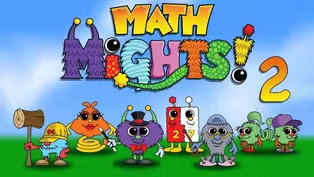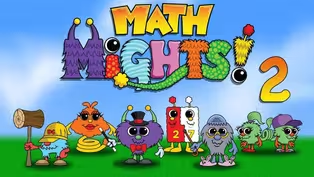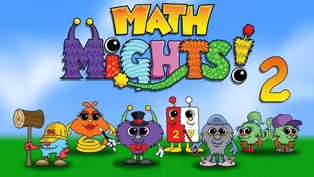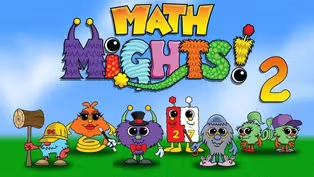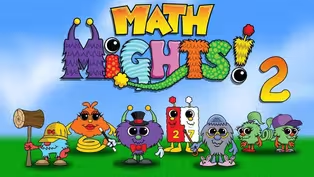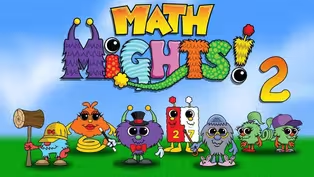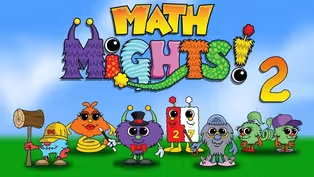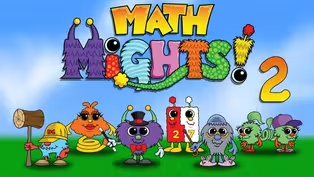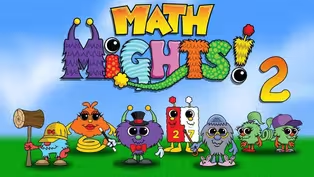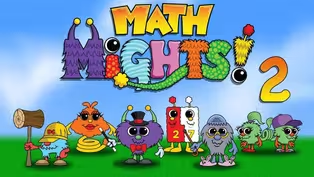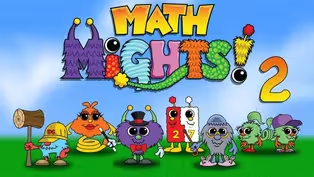Math Mights
Numbers represented in different ways
Season 3 Episode 302 | 15m 59sVideo has Closed Captions
Representing numbers in different ways to show off your learning with place value.
Join Mrs. McCartney to talk about numbers with Springling! Then be ready to take on the challenge of representing numbers in different ways to show off your learning with place value!
Problems playing video? | Closed Captioning Feedback
Problems playing video? | Closed Captioning Feedback
Math Mights is a local public television program presented by Detroit PBS
Math Mights
Numbers represented in different ways
Season 3 Episode 302 | 15m 59sVideo has Closed Captions
Join Mrs. McCartney to talk about numbers with Springling! Then be ready to take on the challenge of representing numbers in different ways to show off your learning with place value!
Problems playing video? | Closed Captioning Feedback
How to Watch Math Mights
Math Mights is available to stream on pbs.org and the free PBS App, available on iPhone, Apple TV, Android TV, Android smartphones, Amazon Fire TV, Amazon Fire Tablet, Roku, Samsung Smart TV, and Vizio.
Providing Support for PBS.org
Learn Moreabout PBS online sponsorshipMore from This Collection
"Math Mights" lessons for 2nd Grade students.
Video has Closed Captions
Join Mrs. McCartney for some fun with Professor Barble. (15m 59s)
Video has Closed Captions
Join Mrs. McCartney for some fun with Professor Barble. (15m 59s)
Video has Closed Captions
Join Mrs. McCartney for some fun with Professor Barble doing a tricky comparison. (15m 59s)
Video has Closed Captions
Join Mrs. McCartney for a word problem with Professor Barble that will make more sense. (15m 58s)
Video has Closed Captions
Join Mrs. McCartney for a comparison word problem with her friend Professor Barble. (15m 59s)
Compare 3-Digit Numbers Part 2
Video has Closed Captions
Join Mrs. McCartney to learn how to do a comparison word problem with Professor Barble! (15m 59s)
Comparing Numbers on a Number line
Video has Closed Captions
Join Mrs McCartney for a word problem with Professor Barble using Visula Models! (15m 59s)
Compare 3-Digit Numbers Part 1
Video has Closed Captions
Join Mrs. McCartney to see if we can figure out Professor Barble's comparison. (15m 59s)
Video has Closed Captions
Put numbers together and taking them apart with expanded form. (15m 59s)
Video has Closed Captions
Join Mrs, McCartney for a Number Talk with her friend Springling! (15m 59s)
Video has Closed Captions
Join Mrs, McCartney for a Number Talk with her friend Springling! (16m)
Subtraction with 2-Digit Numbers Part 2
Video has Closed Captions
Join Mrs. McCartney for an addition number talk with D.C.! (16m)
Providing Support for PBS.org
Learn Moreabout PBS online sponsorship(playful music) (electronic gadgets clinking) - [Children] Math Mights!
- Welcome 2nd grade Math Mights.
My name is Mrs. McCartney.
Are you ready to have some fun with math today?
Let's check out our plan for today.
You're gonna be a pro at our number talk today, I just know it, with subtraction, and then we're gonna start to work on looking at numbers represented in different ways.
Let's start off with our warmup to get our math brain ready with our number talk.
You remember how to do a number talk.
I'm gonna pose a problem to you with an operation that you already are familiar with.
You are going to think mentally on how to solve that problem in your head.
These problems are set up on purpose to help you mentally think about it and not use any pencil and paper.
And then we're gonna talk about our strategies and share them out to see how you solve them.
Let's see what Math Might character is going to help us with our number talk today.
You guessed it.
It's our friend Springling.
You remember her, she has fluffy fur and fancy eyelashes and has a coily tail.
She loves to hop on that open number line.
I want you to mentally think about how Springling is going to solve the subtraction problem that I'm gonna give you today.
Think about hopping in friendly chunks.
Let's see what our problem is.
The problem today is 65 minus 39.
I bet that you can do this mentally in your head as we think about it.
Let's take a look to see how our friend Nolan solved the problem.
He looked at this problem by hopping to a friendly decade number.
Remember decades are 10, 20, 30, 40, and then he continued on his number line.
Let's check it out to see exactly how he solved it.
He hopped from the 39 to the 40 because he knows that's a friendly number.
It's gonna be easier to hop once we move on.
Hop, Springling, hop!
That is one.
Now some of you might decide that you want to go from 40 to 50, which is 10, and then go from 50 to 60.
And that's okay.
Springling loves to hop really high to make her fur really fluffy.
So if you can go 20, she'd be really excited.
Let's see how Nolan did it.
He stopped here at the 60, and hop, Springling, hop!
She flew all the way from 40 to 60.
We know between 40 and 60, it is 20.
And then from 60 to 65, that's easy.
We can put our five.
Springling loves to keep track of her hops.
So we're gonna add our 20 plus our 5 plus our 1, which is gonna give us the answer that Nolan had, which was 26.
Perhaps you came up with a different way to do it on the number line or a completely different strategy.
That's the fun thing about number talks is we can hear all the different ways that you might want to solve the problem.
Let's check out now our I can statement for today.
I can read, write and represent three-digit numbers, including number names.
Number names sometimes in 2nd grade, I'll be honest, are hard for us to spell.
So we'll work on that today.
Let's see first what we want to take a look at to get this idea.
I want you to take a close look at that and decide which one of those doesn't belong.
Let's see what our friends think.
Nolan has some thoughts about which one doesn't belong.
He said, "A is the only one that doesn't show "the value of the individual units."
Let's take a look.
So here we have the units of the hundreds and the tens and the ones.
We obviously can see that here in the Base 10 Blocks.
And then we can see it here.
He's saying that this one doesn't show the individual units because it's the words written out with the total number.
He also has some thoughts about C, which honestly is the one that I was thinking of.
He said that when he looked at it, that C is the only one that doesn't represent 325.
Did you pick that out?
Let's check it out.
This one says 325.
This one I see 320, and then I see 5.
Here I see three hundreds, two tens and five ones, which equals 325.
This one here represents 253.
So that's another reason why this one might not belong.
Let's see what Jade is thinking.
Jade has a thought about D. She said, "It's the only one that doesn't use "just one representation.
"It has numbers and words together."
Let's see what she means.
This here shows the full number of 253, so that only has one representation.
Here, we see 325.
So it has the numbers in the number words.
This here has just the one way of showing it with the blocks.
But here we have actual numbers and words together showing the number that it is total.
Honestly, if you looked at it, you probably would be saying to yourself that C is the one that doesn't belong.
But when looking at place value, there's different characteristics about this.
This is showing it in word form.
This is showing it in Base 10 form.
This is showing it in that number that we see.
And then this is showing how many hundreds, how many tens and how many ones.
Today, we're gonna do a lot of learning with really applying this in multiple ways for you to be able to take a number and be able to represent it in not just one way as we look at it.
So let's take a look at one of those forms.
It says, write the number in word form.
Nolan has an idea.
He sees the number 588 and he writes it five hundred and eighty-eight.
Do you agree or disagree with the way that Nolan wrote it out in the word form?
Hmm, I have a feeling one of my friends is gonna have something to say about this.
Let's see who it is.
(cheerful whistling music) My friend the Value Pak is wondering about Nolan's thinking.
And I'm wondering if you caught on too.
I haven't told you this yet, but the Value Pak family is huge.
They also have numbers that are in the decimals for when you get to 4th and 5th grade.
Let's see what Jade thinks.
She's saying, "Wait a minute, "he wrote five hundred and eight-eight."
Is that really what is represented in the numbers?
Let's take a closer look.
Here we have 588.
Did you hear the way I said that?
Did you hear me say an and while I was saying it?
No, we just say the number together because it's all a whole number.
Here is how Nolan wrote it.
He wrote five hundred and eighty-eight.
With the Value Pak, these are the tens and these are the hundreds.
Don't worry, you don't have to learn that as a 2nd grader, but the decimal point here actually means and.
So we have to be careful in the way that we're saying numbers and in the way we're writing it in word form.
As 2nd graders, you can think of this as $500 and 88 cents.
Did you hear the and that I said?
When we think of it here as 588, it's kind of the whole number without putting any decimal points in it.
So we could write this in word form by putting five and then writing out hundred.
I don't want to put and because there's no decimal point in our whole numbers.
And then we have the number 80, and then we put a dash to show that it's 88.
You'll learn this as we start to learn how to write numbers.
I would say as a 2nd grader, that's one of the hardest things for kids is to be able to write numbers and be able to spell them correctly.
And when we're going to put numbers together, like 35 or 42, we have to have that dash in there to say it together.
Let's play a game or a challenge.
It's called the five-way challenge.
I'm gonna give you a number and see if you could remember how to only show that in tens and ones, see if you can compose it a different way, make a Base 10 diagram, show it in word form, and then finally put it in expanded form with Value Pak.
Let's give it a try.
The number we're gonna do this with is the number 273.
First, we're going to put it into ones and tens.
Now wait a minute, that number has a hundred in it.
So I want you to think back to what you know about hundreds, tens and ones.
I have the number here displayed on the place value disks.
273.
We are not allowed to use these hundreds, but I still want to see the value of 273.
What are you thinking that we might do to show this?
I'm gonna take my hundred and see if I can cash it in for 10 tens.
We know that 10 tens is the same as 100.
Now I'm gonna take my other hundred and exchange that for another 10 tens, because 10 tens equals a hundred, and we're trying to show this with only tens and ones.
So now we can see that we have it only in tens and ones.
So we have that number 273.
We know that it equals how many tens?
We have 10, 20, 21, 22, 23, 24, 25, 26, 27 tens.
How many ones can we do?
One, two, three.
So we know that equals 27 tens and three ones equals 273.
You did a great job showing how you could make that number with just tens and ones.
Do you think that you can compose that number a different way?
Let's take a look.
We have here our 27 tens and our 3 ones.
Let's see if we can rename the number 273 a different way.
What happens if we took one of our tens and we cashed it in for 10 ones?
Let's check this out to see if we can figure out the total.
As you can see, I broke apart that 10 into 10 ones.
We still have the same quantity.
I mean, I think.
Did the quantity change at all?
Let's check to make sure.
Here we have our 10, 11, 12 13, 14, 15, 17, 18, 19, 20, 21, 22, 23, 24, 25, 26 tens.
And let's see how many ones.
We have 10, 11, 12, 13.
Well, I think we could check to add that together.
We have 100.
We could bring this over here to say that it's 200, and then we have 60 plus 10, which is 70.
And then three more.
So in fact, breaking this a different way, making 273.
26 tens and 13 ones is another way to represent that number.
Now let's try to see if we can show this in a Base 10 diagram.
Here we have this created.
273.
This is a Base 10 diagram, 'cause I actually have the manipulatives, but you can also record this in a drawing, which would be Base 10.
So I could show two squares to represent my two hundreds, and then I could do seven lines to make up, to show that that is equal to my tens that I have.
And then I could do dots for my ones.
Some students that are using these proportional manipulatives might want to show it this way.
Now that we've done it in a Base 10 diagram, let's show it using the word form that we learned earlier.
Here we have 273.
I put this helpful stem to help us.
Blank hundred, and then when we go to make this number, 73, we have the hyphen there.
So you see the dash already put in.
So let's put this.
We're not gonna put the number two because we want to be able to put it in word form.
So we're going to write two hundred seventy-three.
The last part that we're gonna do is show this in expanded form.
We've worked a lot on this concept and we know that Value Pak really helps us with this idea.
So I have our cards here with our place value strips, building the number 273.
If we want to show it in expanded form, it looks like this.
We have 200 plus 70 plus 3 gives us our number 273.
You did amazing!
Did you realize you took one number and you showed it five different ways.
You're getting really smart at this place value stuff.
I know that you're doing amazing.
Now it's your turn to be able to play the game the five-way challenge.
Are you able to take a number and show us the five ways that we just did it, showing it in ones and tens, composing it a different way, showing that Base 10 diagram, in that new word form, and then also in expanded form.
I've had such an awesome time with you today from our number talk was Springling at the beginning, to really looking at how we can take place value to a whole nother level using expanded form, word form, we used place value diffs, Base 10 Blocks.
Wow!
You're doing awesome work.
I so hope that you'll join us next time.
(playful music) (cheerful whistling music) - [Boy] Sis4teachers.org.
- [Girl] Changing the way you think about math.
- [Announcer] This program is made possible with funding from the Michigan department of Education, Governor's Education Emergency Funds, the State of Michigan, and by viewers like you.
(cheerful music continues)


- Home and How To

Hit the road in a classic car for a tour through Great Britain with two antiques experts.












Support for PBS provided by:
Math Mights is a local public television program presented by Detroit PBS
